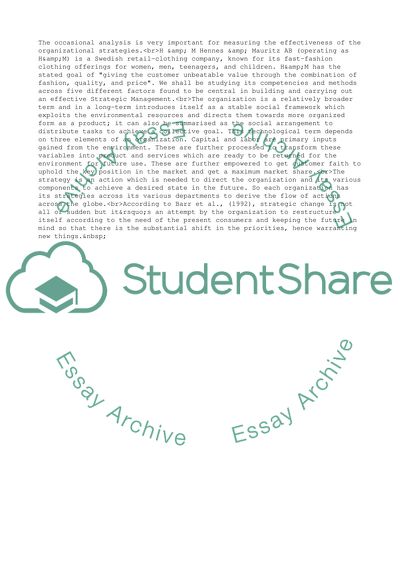Cite this document
(Strategic Management of H & M Hennes & Mauritz AB Essay - 1, n.d.)
Strategic Management of H & M Hennes & Mauritz AB Essay - 1. Retrieved from https://studentshare.org/management/1750977-strategic-management-module-question-critically-examine-the-international-expansion-strategy-for-an-organisation-of-your-own-choice-during-a-specific-period-of-its-expansion-explain-the-motivations-for-the-expansion-and-discuss-the-approach-to-interna
Strategic Management of H & M Hennes & Mauritz AB Essay - 1. Retrieved from https://studentshare.org/management/1750977-strategic-management-module-question-critically-examine-the-international-expansion-strategy-for-an-organisation-of-your-own-choice-during-a-specific-period-of-its-expansion-explain-the-motivations-for-the-expansion-and-discuss-the-approach-to-interna
(Strategic Management of H & M Hennes & Mauritz AB Essay - 1)
Strategic Management of H & M Hennes & Mauritz AB Essay - 1. https://studentshare.org/management/1750977-strategic-management-module-question-critically-examine-the-international-expansion-strategy-for-an-organisation-of-your-own-choice-during-a-specific-period-of-its-expansion-explain-the-motivations-for-the-expansion-and-discuss-the-approach-to-interna.
Strategic Management of H & M Hennes & Mauritz AB Essay - 1. https://studentshare.org/management/1750977-strategic-management-module-question-critically-examine-the-international-expansion-strategy-for-an-organisation-of-your-own-choice-during-a-specific-period-of-its-expansion-explain-the-motivations-for-the-expansion-and-discuss-the-approach-to-interna.
“Strategic Management of H & M Hennes & Mauritz AB Essay - 1”, n.d. https://studentshare.org/management/1750977-strategic-management-module-question-critically-examine-the-international-expansion-strategy-for-an-organisation-of-your-own-choice-during-a-specific-period-of-its-expansion-explain-the-motivations-for-the-expansion-and-discuss-the-approach-to-interna.


